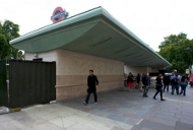Sea Strata by John Maine, Art on the Underground
Date uploaded: May 9, 2012
Sea Strata by John Maine
Art on the Underground
Sea Strata is a new work of art for Green Park Underground station by Royal Academician John Maine. The work is a significant and integral element of the improvement and upgrading of the station. Maine was commissioned by Art on the Underground, to develop a unified work for the walls and flooring of all the station buildings above ground.
The concept of John Maine’s work for Green Park station is grounded in the natural world, reflecting the location between the urban character of Piccadilly and the more rural Green Park beyond.
Green Park Underground station is one of busiest interchange stations on the London Underground system. The major improvements to the station include step-free access between street and platform levels, a new station canopy on the south side of Piccadilly over an enlarged staircase into the station, and restructured station buildings which frame the views from Piccadilly into The Royal Park. These buildings provide the principal area for Maine’s artwork.
At present there are two related elements of the artwork: the Portland stone cladding of the station buildings with related walls and coping; and the granite pavement, which has been incised with a sequence of spirals.
Portland stone is a limestone that continues to be used for many of London’s buildings, often as a neutral cladding material. Maine’s work at Green Park station draws attention to the distinct character of the stone, as a layered material in the quarry. He has used the Portland stone to make the station’s anonymous service buildings, with very few doors or other features, relate to the appearance of natural stone outcrops. The cladding is set in bands or layers that continue across all the buildings to suggest the strata of the stone as it sits in the ground at Portland. At eye level, a frieze of drawn shapes derived from enlarged Portland fossils has been incised into the stone. Below this, a band of Roach stone incorporates a drip course moulding that coincides with the carved coping of the low walls throughout.
Maine himself has described his project in the following way: 'I wanted to the use the Portland stone of the walls to explore the natural composition of the rock and to draw out the internal structure of the material, revealing the fossil remains of marine creatures from 150 million years ago. I imagined the four small buildings as outcrops with strata linking across from one to another. By rounding the corners of the buildings, they take on a more solid feel, and the various bands wrapping around the walls emphasize the natural layers, which you would find in a Portland quarry.
I selected a bed of stone that is particularly rich in fossils; the so-called ‘spiral gastropods’, which look like small arrows made from sharp cone forms. In the stone they may be no more than 8 cms long, but I examined them closely and decided to draw them on a much larger scale. I have incised these fossil enlargement drawings on a band of clear stone that runs around all the buildings.
The wall coping combines with drip courses on the buildings to establish clear horizontals which reveal the Portland stone as more than a simple laminate. It has become a sculptural form.
The skirting of the buildings is made of much harder granite, from the famous old quarries at Kemnay in Aberdeenshire. The floor is paved with granite from various countries, each slab marked with an incised spiral. In the eighteenth century there was a rectangular reservoir at this very spot, where people promenaded. The turbulent paving now acts as a reminder of that surface of water, and also refers to the layering of fossils which once formed the sea bed.'
The art commission for this station is one of a series of permanent art projects by Art on the Underground that are being delivered as part of the upgrade of a small number of stations. John Maine’s work, Sea Strata, introduces a meaningful concept and artistic sensibility into the Green Park station environs and contributes to the way London’s communities and visitors can experience art in their daily lives.
John Maine is best known for making large outdoor sculpture in stone which relates to the surrounding landscape. His work utilises simple forms such as rings, columns and cones as well as an element of drawing. Physical weight and texture also characterise his sculpture which encourages contemplation and a celebration of the elements. His extensive travels have informed his work and he has created monumental installations in many parts of the world.
From 9 November to 18 December 2011, at the Royal Academy in Piccadilly, John Maine RA will make a new interior sculpture in his exhibition Artists’ Laboratory 04, After Cosmati.

